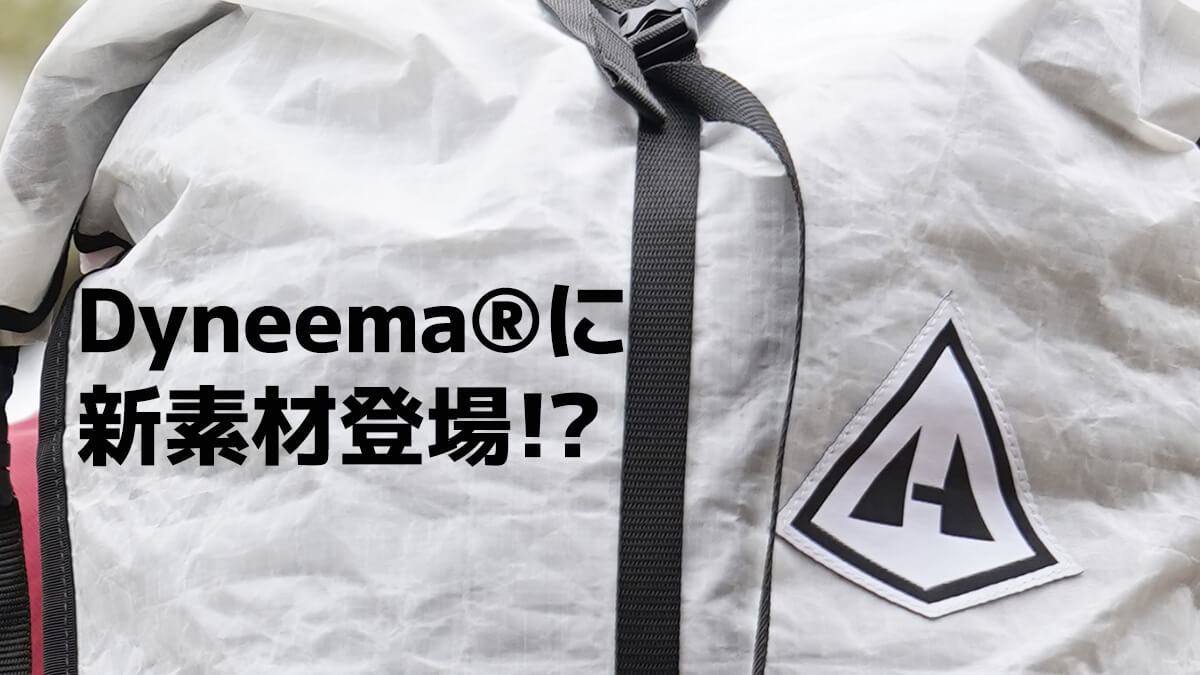One day in August, Hyperlite Mountain Gear, a well-known manufacturer of UL backpacks, suddenly announced some big news: they were relaunching their flagship hiking backpacks, the Windrider, Junction, and Southwest.
The biggest highlight is that it is the first to use DWC (Dyneema Woven Composite), an evolved version of the conventional DCH (Dyneema Composite Hybrid) fabric.
So, in this article, I'd like to explain what kind of fabric this new DWC is and what has evolved from it. While I'm at it, I'd also like to take this opportunity to provide a quick refresher on Dyneema.
table of contents
First of all, what is Dyneema?
Dyneema was first developed in the Netherlands in 1963, and became widely known in 1992 as the canvas used in the America's Cup-winning yacht under the name "Cuben Fiber" (Dyneema® is a trademark of AVIENT). Since then, Dyneema has spread to all industries, being used in protective clothing, fishing nets, medical applications, and of course, UL outdoor gear.
Dyneema characteristics
-
UHMW-PE (Ultra High Molecular Weight Polyethylene) is an ultra-high molecular weight polyethylene that has a molecular weight of 1 million to 7 million, up from the usual 20,000 to 300,000. Dyneema® is a trademark of AVIENT.
-
It is approximately 15 times stronger than steel of the same weight, boasting a maximum tensile strength of 42.5cN/dtex.
-
It is surprisingly light, with a specific gravity of less than 1.0 (lighter than water).
-
It also has excellent cut resistance, abrasion resistance, and UV resistance.
-
It has low water absorption and excellent shape stability.
Why is it perfect for the outdoors?
Simply put, it's because it's lightweight yet offers strength, waterproofness, and stability that most conventional fabrics can't match.
-
Completely waterproof: Unlike coatings that wear off and deteriorate, the film layer forms a permanent waterproof barrier.
-
Non-absorbent: It won't absorb water or gain weight, even after days of rain.
-
Near-zero stretch: Keeps your tent upright in wet and windy conditions and prevents your pack from sagging even when loaded.
-
Exceptional strength: Dyneema fibers give the fabric excellent tear resistance to its weight, making it ideal for demanding environments.
-
Easy to repair: Small tears can be quickly repaired with duct tape, unlike tents like the Silpoli, which require special glues that are rare on the trail.
Dyneema as a fabric, and its characteristics (differences between DCF, DCH, and DWC)
Although the term "Dyneema" is used broadly, there are several different fabric structures to suit different products, such as tents, tarps, backpacks, and stuff sacks.
Most of the species you see outdoors are
-
DCF (Dyneema® Composite Fabric)
-
DCH (Dyneema® Composite Hybrid)
And the new fabric that has just been released
-
DWC (Dyneema® Woven Composites)
There are three of them:
Both use Dyneema fiber, but their construction varies depending on the application.
Dyneema Composite Fiber (DCF): The Original Ultralight Laminate
(Quote: Hyperlite Mountain Gear website)
This material is made of Dyneema fibers sandwiched between thin polyester films. It is waterproof, strong for its weight, and has low stretch, but is susceptible to abrasion. It is suitable for tents, tarps, packing cubes, stuff sacks, peg bags, and more.
Dyneema Composite Hybrid (DCH): Significantly improved abrasion resistance
For durability and abrasion resistance, a Dyneema® composite core is laminated to a woven fabric (such as polyester or nylon), resulting in an ultra-lightweight material that can withstand long distances in harsh environments, making it ideal for backpacks and other applications.
Dyneema Woven Composite (DWC): Even stronger and more durable
DWC has a base Dyneema® core with a Dyneema® fabric bonded to the surface (rather than a polyester or nylon fabric), and the back is made waterproof with the same laminate as the other two.
(Source: BACKPACKER.com)
By using Dyneema fiber in both the inner and outer layers of the fabric, the double-layer construction dramatically improves strength and abrasion resistance. Compared to existing Dyneema composites, it has 10 times the abrasion resistance, 5 times the tear strength, and is 34 percent lighter. In other words, by utilizing the power of Dyneema in both the woven surface and the inner filament core, it is lighter, more durable, and more tear-resistant.
Of course, it also has the dimensional stability, light weight, and waterproofing that are typical of Dyneema®. Best of all, it's quieter than traditional backpacks, with less of a crackling sound.
It's amazing that DCH, which was already super lightweight and durable, has become even stronger. In recent years, the rise of "Ultra fabrics" and "ALUULA Graflyte™" has diminished the dominance of Dyneema as a backpack fabric, but this new evolution is truly a testament to its status as the leader of UL materials.
Is DWC superior to other competing materials?
Dyneema publishes some strength and durability metrics for the DWC, but these do not allow for a direct comparison of strength or weight with competitors.
Because each company publishes different types of information and conducts different tests, it will remain difficult to accurately compare DWC to other cutting-edge, lightweight, and durable materials.
Still, according to publicly available information, the tear strength of 200 denier DWC is 250 pounds, which is close to the tear strength of 800 denier Ultra, so we can imagine that the tear strength of DWC is extraordinary.
Finally: What are the drawbacks of Dyneema?
Like any material, even the incredibly strong-to-weight superfabric Dyneema isn't perfect, and there are some compromises you have to make in exchange for it (though these may be resolved in the future).
1. Expensive
Its biggest drawback is its price, which is often two to three times the price of comparable gear made from nylon or polyester.
2. Noise and wrinkles easily occur
Because of its laminated structure, it is noticeably more prone to rustling and wrinkling than other tents. The noise it makes when flapping in the wind or folding up when packing is noticeably louder than other tents, and while the resulting wrinkles can be seen as a positive addition to the tent's texture, they ultimately affect the strength of the fabric, so it's best to avoid them altogether.
3. Limited color variations
Most products are white, gray, or muted colors, and even the bright colors are only available in a few places. On the flip side, seeing a colorful Dyneema stuff sack is appealing in itself.
4. The fabric is see-through
This can be both an advantage and a disadvantage, but it does allow a slight sheerness to show through, something to consider when buying an ultralight Dyneema tent.
5. Heat-sensitive
Compared to other fabrics, it is more likely to deform and deteriorate when exposed to fire. For example, it can quickly shrink, deform, or melt if exposed to sparks. This is because the polyethylene it is made of is sensitive to heat, so it is important not to use it at temperatures above 70°C or iron it at temperatures above that.
6. Layers easily peel off under strong stress
Strong bending or prolonged stress can cause the film layers to peel over time.
7. Deterioration over time due to ultraviolet rays
Like any fabric, prolonged exposure to strong sunlight can gradually weaken the laminate and shorten the lifespan of Dyneema, especially if it's left outside for weeks or months.
summary
DWC is currently a premium material used only in HMG backpacks, but it will surely be made available to other brands from next year onwards. With its improved outstanding strength-to-weight ratio, permanent waterproofing, lightness, ease of handling and high reliability, the arrival of DWC may once again bring Dyneema back to its position as the strongest UL material. Keep an eye out for upcoming new products using DWC.
reference:
https://hyperlitemountaingear.com/pages/material-technology
https://hyperlitemountaingear.com/blogs/the-trailhead/a-deep-dive-into-our-new-pack-fabric
https://www.dyneema.com/design-with-dyneema/dyneema-woven-composites
https://www.backpacker.com/gear/dyneema-unveils-a-new-composite-fabric/


